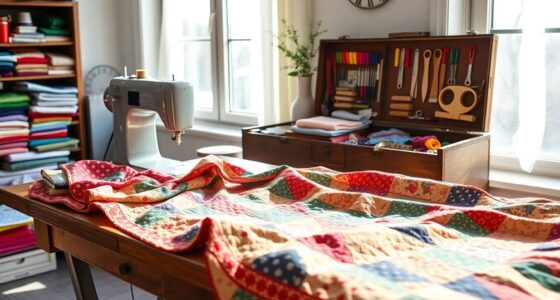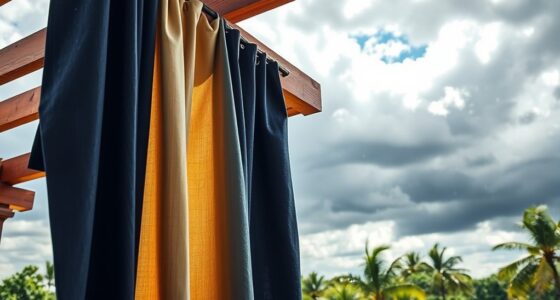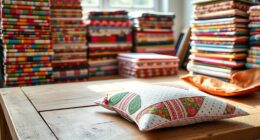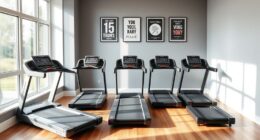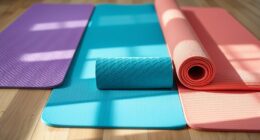To soundproof your home studio with smart textiles, start by adding acoustic panels at reflection points to absorb sound and prevent echoes. Use heavy curtains over windows and doors to block external noise, and place thick rugs on the floor to reduce vibrations. Foam tiles on walls or ceilings further enhance absorption, creating a layered soundproof environment. Keep exploring for more tips on crafting a studio with ideal acoustic treatment.
Key Takeaways
- Use acoustic panels at reflection points to absorb sound and reduce echo for clearer recordings.
- Incorporate heavy curtains over windows and doors to block external noise leaks.
- Place thick rugs on the floor to absorb vibrations and minimize sound bouncing.
- Install foam tiles on walls or ceilings to enhance sound absorption in critical areas.
- Combine textiles like curtains, rugs, and panels for layered soundproofing and optimal noise reduction.
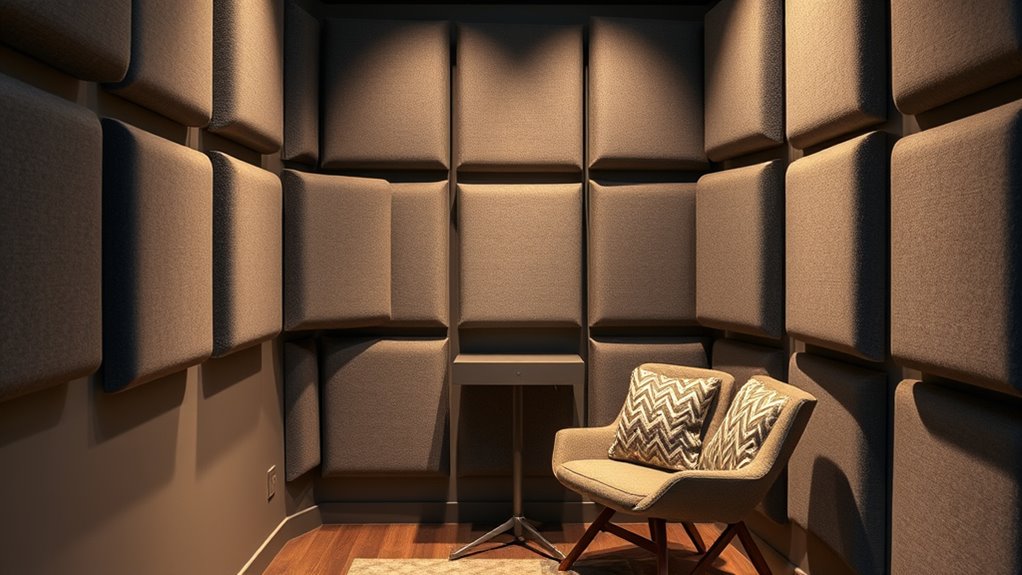
Creating a soundproof home studio is essential to guarantee your recordings are clear and free from external noise. When you’re setting up your space, your focus should be on both the quality of your studio gear and the acoustic environment you create. While high-quality microphones, headphones, and audio interfaces are necessary, they won’t reach their full potential if outside sounds seep in or echoes distort your recordings. That’s where acoustic panels come into play. They’re not just decorative; they’re fundamental tools for controlling sound reflections and reducing noise interference. By strategically placing acoustic panels around your studio, especially on walls prone to bouncing sound, you can greatly improve the clarity and professionalism of your recordings.
Investing in the right studio gear is just the beginning. To truly block out external noise, you need to contemplate the room’s acoustics. Acoustic panels absorb sound waves, preventing them from bouncing around and creating unwanted reverberations. This results in a cleaner, more accurate sound. You’ll notice the difference immediately when your recordings sound crisp and well-defined, without the muddiness caused by echo or background noise. The placement of these panels matters—install them at reflection points and areas where sound tends to bounce most. They’re available in various sizes and designs, making it easy to match your studio’s aesthetic while boosting its acoustic performance.
Beyond acoustic panels, you can also incorporate other textiles like heavy curtains, rugs, and foam tiles to further dampen sound. These materials are affordable and easy to install, making them perfect for a home studio environment. Heavy curtains over windows and doors can block out street noise and prevent sound leaks. Thick rugs on the floor absorb sound vibrations and improve the overall acoustic quality. Foam tiles, especially those designed for soundproofing, can be placed on walls or ceilings to add an extra layer of sound absorption. Combining these textiles with acoustic panels creates a layered approach, ensuring your studio is as soundproof as possible. Additionally, understanding soundproofing principles can help you optimize your setup for the best results.
Frequently Asked Questions
Can Acoustically Smart Textiles Be Reused After Installation?
When asking if acoustically smart textiles can be reused after installation, you should consider reusability concerns and installation considerations. Typically, these textiles are designed for permanence, so reusing them might be challenging once installed. However, if they are removable or modular, you could potentially reuse them, but it depends on the specific product. Always check manufacturer guidelines to guarantee proper reinstallation and avoid damage.
How Do Textiles Affect the Overall Room Temperature?
When it comes to textiles and room temperature, you’re really playing with fire if you don’t consider their impact. These fabrics help with thermal insulation, keeping heat in during winter and out in summer. They also assist in humidity control, preventing the air from becoming too damp or dry. So, by choosing the right textiles, you can make your space more comfortable without turning up the thermostat unnecessarily.
Are There Aesthetic Options for Soundproof Textiles?
You can find many aesthetic options for soundproof textiles, including decorative fabric options that match your style. These textiles come in a variety of colors and textures, allowing for color customization to suit your space. Whether you prefer bold patterns or subtle hues, you can enhance your room’s look while improving sound absorption. Choose textiles that complement your decor, creating a stylish and functional soundproof environment effortlessly.
Do Textiles Impact the Quality of Sound Recordings?
You might find it surprising, but textiles directly impact your sound recordings. They enhance sound absorption, reducing echo and reverberation, which leads to clearer audio. By minimizing unwanted noise, textiles improve noise reduction, ensuring your recordings are crisp and professional. When chosen wisely, they not only serve aesthetic purposes but also play a vital role in maintaining sound quality, making your home studio a more effective, inviting space for your creative work.
What Maintenance Is Required for Acoustically Smart Textiles?
You should regularly inspect your acoustically smart textiles for wear and tear, ensuring fabric durability stays intact. Cleaning procedures depend on the material; generally, you can gently vacuum or spot clean with a damp cloth. Avoid harsh chemicals and excessive moisture to preserve sound absorption qualities. By maintaining proper care, your textiles will continue to effectively improve your studio’s acoustics and last longer.
Conclusion
By choosing the right acoustically smart textiles, you transform your home studio into a sanctuary of sound, where creativity flows freely. Think of these textiles as the unsung heroes that quietly banish echoes and unwanted noise, giving your recordings clarity and precision. So, why settle for a noisy space when a simple upgrade can make your studio a haven? Embrace these textiles today, and let your soundproofing journey be as inspiring as the music you’ll create.


